Lexus ES: "HAVE TRACTION BATTERY INSPECTED" is displayed
DESCRIPTION
The battery ECU assembly monitors the SOC (state of charge) of the HV battery. When it finds the HV battery has deteriorated excessively, it will display "Have Traction Battery Inspected" on the multi-information display. If "Have Traction Battery Inspected" is displayed, perform "Battery Diagnosis" and replace the HV battery as necessary.
CAUTION / NOTICE / HINT
CAUTION:
-
Before the following operations are conducted, take precautions to prevent electric shock by turning the power switch off, wearing insulated gloves, and removing the service plug grip from HV battery.
.png)
- Inspecting the high-voltage system
- Disconnecting the low voltage connector of the inverter with converter assembly
- Disconnecting the low voltage connector of the HV battery
-
To prevent electric shock, make sure to remove the service plug grip to cut off the high voltage circuit before servicing the vehicle.
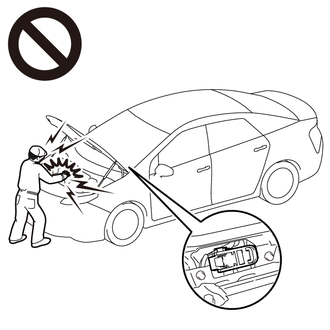
-
After removing the service plug grip from the HV battery, put it in your pocket to prevent other technicians from accidentally reconnecting it while you are working on the high-voltage system.
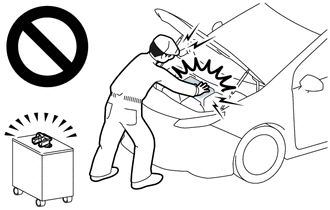
-
After removing the service plug grip, wait for at least 10 minutes before touching any of the high-voltage connectors or terminals. After waiting for 10 minutes, check the voltage at the terminals in the inspection point in the inverter with converter assembly. The voltage should be 0 V before beginning work.
Click here
.gif)
.gif)
HINT:
Waiting for at least 10 minutes is required to discharge the high-voltage capacitor inside the inverter with converter assembly.
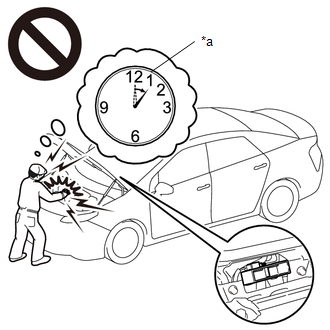
*a
Without waiting for 10 minutes
-
Make sure to insulate the high-voltage connectors and terminals of the HV battery with insulating tape after removing it.
If the HV battery stored without insulating the connectors and terminals, electric shock or fire may result.
-
When disposing of an HV battery, make sure to return it through an authorized collection agent who is capable of handling it safely. If the HV battery is returned via the manufacturer specified route, it will be returned properly and in a safe manner by an authorized collection agent.
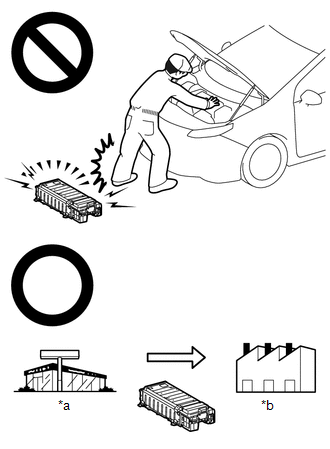
*a
Dealer
*b
Battery Collection Agent
- Accidents such as electric shock may result if the HV battery is disposed of improperly or abandoned. Therefore, make sure to return all HV batteries through an authorized collection agent.
-
Before returning the HV battery, make sure to perform a recovery inspection.
Click here
.gif)
-
Before returning the HV supply stack sub-assembly, make sure to perform a recovery inspection.
Click here
.gif)
- Make a note of the output DTCs as some of them may be necessary for recovery inspection of the HV battery and HV supply stack sub-assemblies.
-
After removing the HV battery, keep it away from water. Exposure to water may cause the HV battery to produce heat, resulting in a fire.
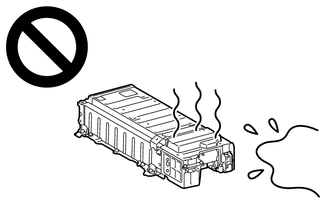
NOTICE:
-
If "Have Traction Battery Inspected" is displayed on the multi-information display, the message will not be cleared until one of the following conditions is met. If the traction battery is used continually without performing battery diagnosis for a few weeks*, "VEHICLE START WILL SOON BE DISABLED" and "Have Traction Battery Inspected" are displayed and the use of the HV battery is limited. If it is used more, the power on (READY) operation will be disabled.
*: The timing may vary depending on vehicle usage.
-
"Have Traction Battery Inspected" is cleared when both of the following conditions are met:
- "Prediagnostic Battery Charge" and "Battery Diagnosis" have been performed.
- "003" (There is no need to replace HV battery) is displayed on the Techstream.
-
After turning the power switch off, waiting time may be required before disconnecting the cable from the negative (-) auxiliary battery terminal. Therefore, make sure to read the disconnecting the cable from the negative (-) auxiliary battery terminal notices before proceeding with work.
Click here
.gif)
.gif)
PROCEDURE
| 1. | READ VALUE USING TECHSTREAM (HYBRID/EV BATTERY CELL 1 TO 70 INTERNAL RESISTANCE) |
(a) Connect the Techstream to the DLC3.
(b) Turn the power switch on (IG).
(c) Enter the following menus: Powertrain / HV Battery / Data List / Hybrid/EV Battery Cell 1 to 70 Internal Resistance.
Powertrain > HV Battery > Data List| Tester Display | Measurement Item | Range | Normal Condition |
|---|---|---|---|
| Hybrid/EV Battery Cell 1 Internal Resistance | Internal resistance of each battery cell | Min.: 0.000 ohm, Max.: 0.025 ohm | Always: 0.006 Ω or less |
| Hybrid/EV Battery Cell 2 Internal Resistance | Internal resistance of each battery cell | Min.: 0.000 ohm, Max.: 0.025 ohm | Always: 0.006 Ω or less |
| Hybrid/EV Battery Cell 3 Internal Resistance | Internal resistance of each battery cell | Min.: 0.000 ohm, Max.: 0.025 ohm | Always: 0.006 Ω or less |
| Hybrid/EV Battery Cell 4 Internal Resistance | Internal resistance of each battery cell | Min.: 0.000 ohm, Max.: 0.025 ohm | Always: 0.006 Ω or less |
| Hybrid/EV Battery Cell 5 Internal Resistance | Internal resistance of each battery cell | Min.: 0.000 ohm, Max.: 0.025 ohm | Always: 0.006 Ω or less |
| Hybrid/EV Battery Cell 6 Internal Resistance | Internal resistance of each battery cell | Min.: 0.000 ohm, Max.: 0.025 ohm | Always: 0.006 Ω or less |
| Hybrid/EV Battery Cell 7 Internal Resistance | Internal resistance of each battery cell | Min.: 0.000 ohm, Max.: 0.025 ohm | Always: 0.006 Ω or less |
| Hybrid/EV Battery Cell 8 Internal Resistance | Internal resistance of each battery cell | Min.: 0.000 ohm, Max.: 0.025 ohm | Always: 0.006 Ω or less |
| Hybrid/EV Battery Cell 9 Internal Resistance | Internal resistance of each battery cell | Min.: 0.000 ohm, Max.: 0.025 ohm | Always: 0.006 Ω or less |
| Hybrid/EV Battery Cell 10 Internal Resistance | Internal resistance of each battery cell | Min.: 0.000 ohm, Max.: 0.025 ohm | Always: 0.006 Ω or less |
| Hybrid/EV Battery Cell 11 Internal Resistance | Internal resistance of each battery cell | Min.: 0.000 ohm, Max.: 0.025 ohm | Always: 0.006 Ω or less |
| Hybrid/EV Battery Cell 12 Internal Resistance | Internal resistance of each battery cell | Min.: 0.000 ohm, Max.: 0.025 ohm | Always: 0.006 Ω or less |
| Hybrid/EV Battery Cell 13 Internal Resistance | Internal resistance of each battery cell | Min.: 0.000 ohm, Max.: 0.025 ohm | Always: 0.006 Ω or less |
| Hybrid/EV Battery Cell 14 Internal Resistance | Internal resistance of each battery cell | Min.: 0.000 ohm, Max.: 0.025 ohm | Always: 0.006 Ω or less |
| Hybrid/EV Battery Cell 15 Internal Resistance | Internal resistance of each battery cell | Min.: 0.000 ohm, Max.: 0.025 ohm | Always: 0.006 Ω or less |
| Hybrid/EV Battery Cell 16 Internal Resistance | Internal resistance of each battery cell | Min.: 0.000 ohm, Max.: 0.025 ohm | Always: 0.006 Ω or less |
| Hybrid/EV Battery Cell 17 Internal Resistance | Internal resistance of each battery cell | Min.: 0.000 ohm, Max.: 0.025 ohm | Always: 0.006 Ω or less |
| Hybrid/EV Battery Cell 18 Internal Resistance | Internal resistance of each battery cell | Min.: 0.000 ohm, Max.: 0.025 ohm | Always: 0.006 Ω or less |
| Hybrid/EV Battery Cell 19 Internal Resistance | Internal resistance of each battery cell | Min.: 0.000 ohm, Max.: 0.025 ohm | Always: 0.006 Ω or less |
| Hybrid/EV Battery Cell 20 Internal Resistance | Internal resistance of each battery cell | Min.: 0.000 ohm, Max.: 0.025 ohm | Always: 0.006 Ω or less |
| Hybrid/EV Battery Cell 21 Internal Resistance | Internal resistance of each battery cell | Min.: 0.000 ohm, Max.: 0.025 ohm | Always: 0.006 Ω or less |
| Hybrid/EV Battery Cell 22 Internal Resistance | Internal resistance of each battery cell | Min.: 0.000 ohm, Max.: 0.025 ohm | Always: 0.006 Ω or less |
| Hybrid/EV Battery Cell 23 Internal Resistance | Internal resistance of each battery cell | Min.: 0.000 ohm, Max.: 0.025 ohm | Always: 0.006 Ω or less |
| Hybrid/EV Battery Cell 24 Internal Resistance | Internal resistance of each battery cell | Min.: 0.000 ohm, Max.: 0.025 ohm | Always: 0.006 Ω or less |
| Hybrid/EV Battery Cell 25 Internal Resistance | Internal resistance of each battery cell | Min.: 0.000 ohm, Max.: 0.025 ohm | Always: 0.006 Ω or less |
| Hybrid/EV Battery Cell 26 Internal Resistance | Internal resistance of each battery cell | Min.: 0.000 ohm, Max.: 0.025 ohm | Always: 0.006 Ω or less |
| Hybrid/EV Battery Cell 27 Internal Resistance | Internal resistance of each battery cell | Min.: 0.000 ohm, Max.: 0.025 ohm | Always: 0.006 Ω or less |
| Hybrid/EV Battery Cell 28 Internal Resistance | Internal resistance of each battery cell | Min.: 0.000 ohm, Max.: 0.025 ohm | Always: 0.006 Ω or less |
| Hybrid/EV Battery Cell 29 Internal Resistance | Internal resistance of each battery cell | Min.: 0.000 ohm, Max.: 0.025 ohm | Always: 0.006 Ω or less |
| Hybrid/EV Battery Cell 30 Internal Resistance | Internal resistance of each battery cell | Min.: 0.000 ohm, Max.: 0.025 ohm | Always: 0.006 Ω or less |
| Hybrid/EV Battery Cell 31 Internal Resistance | Internal resistance of each battery cell | Min.: 0.000 ohm, Max.: 0.025 ohm | Always: 0.006 Ω or less |
| Hybrid/EV Battery Cell 32 Internal Resistance | Internal resistance of each battery cell | Min.: 0.000 ohm, Max.: 0.025 ohm | Always: 0.006 Ω or less |
| Hybrid/EV Battery Cell 33 Internal Resistance | Internal resistance of each battery cell | Min.: 0.000 ohm, Max.: 0.025 ohm | Always: 0.006 Ω or less |
| Hybrid/EV Battery Cell 34 Internal Resistance | Internal resistance of each battery cell | Min.: 0.000 ohm, Max.: 0.025 ohm | Always: 0.006 Ω or less |
| Hybrid/EV Battery Cell 35 Internal Resistance | Internal resistance of each battery cell | Min.: 0.000 ohm, Max.: 0.025 ohm | Always: 0.006 Ω or less |
| Hybrid/EV Battery Cell 36 Internal Resistance | Internal resistance of each battery cell | Min.: 0.000 ohm, Max.: 0.025 ohm | Always: 0.006 Ω or less |
| Hybrid/EV Battery Cell 37 Internal Resistance | Internal resistance of each battery cell | Min.: 0.000 ohm, Max.: 0.025 ohm | Always: 0.006 Ω or less |
| Hybrid/EV Battery Cell 38 Internal Resistance | Internal resistance of each battery cell | Min.: 0.000 ohm, Max.: 0.025 ohm | Always: 0.006 Ω or less |
| Hybrid/EV Battery Cell 39 Internal Resistance | Internal resistance of each battery cell | Min.: 0.000 ohm, Max.: 0.025 ohm | Always: 0.006 Ω or less |
| Hybrid/EV Battery Cell 40 Internal Resistance | Internal resistance of each battery cell | Min.: 0.000 ohm, Max.: 0.025 ohm | Always: 0.006 Ω or less |
| Hybrid/EV Battery Cell 41 Internal Resistance | Internal resistance of each battery cell | Min.: 0.000 ohm, Max.: 0.025 ohm | Always: 0.006 Ω or less |
| Hybrid/EV Battery Cell 42 Internal Resistance | Internal resistance of each battery cell | Min.: 0.000 ohm, Max.: 0.025 ohm | Always: 0.006 Ω or less |
| Hybrid/EV Battery Cell 43 Internal Resistance | Internal resistance of each battery cell | Min.: 0.000 ohm, Max.: 0.025 ohm | Always: 0.006 Ω or less |
| Hybrid/EV Battery Cell 44 Internal Resistance | Internal resistance of each battery cell | Min.: 0.000 ohm, Max.: 0.025 ohm | Always: 0.006 Ω or less |
| Hybrid/EV Battery Cell 45 Internal Resistance | Internal resistance of each battery cell | Min.: 0.000 ohm, Max.: 0.025 ohm | Always: 0.006 Ω or less |
| Hybrid/EV Battery Cell 46 Internal Resistance | Internal resistance of each battery cell | Min.: 0.000 ohm, Max.: 0.025 ohm | Always: 0.006 Ω or less |
| Hybrid/EV Battery Cell 47 Internal Resistance | Internal resistance of each battery cell | Min.: 0.000 ohm, Max.: 0.025 ohm | Always: 0.006 Ω or less |
| Hybrid/EV Battery Cell 48 Internal Resistance | Internal resistance of each battery cell | Min.: 0.000 ohm, Max.: 0.025 ohm | Always: 0.006 Ω or less |
| Hybrid/EV Battery Cell 49 Internal Resistance | Internal resistance of each battery cell | Min.: 0.000 ohm, Max.: 0.025 ohm | Always: 0.006 Ω or less |
| Hybrid/EV Battery Cell 50 Internal Resistance | Internal resistance of each battery cell | Min.: 0.000 ohm, Max.: 0.025 ohm | Always: 0.006 Ω or less |
| Hybrid/EV Battery Cell 51 Internal Resistance | Internal resistance of each battery cell | Min.: 0.000 ohm, Max.: 0.025 ohm | Always: 0.006 Ω or less |
| Hybrid/EV Battery Cell 52 Internal Resistance | Internal resistance of each battery cell | Min.: 0.000 ohm, Max.: 0.025 ohm | Always: 0.006 Ω or less |
| Hybrid/EV Battery Cell 53 Internal Resistance | Internal resistance of each battery cell | Min.: 0.000 ohm, Max.: 0.025 ohm | Always: 0.006 Ω or less |
| Hybrid/EV Battery Cell 54 Internal Resistance | Internal resistance of each battery cell | Min.: 0.000 ohm, Max.: 0.025 ohm | Always: 0.006 Ω or less |
| Hybrid/EV Battery Cell 55 Internal Resistance | Internal resistance of each battery cell | Min.: 0.000 ohm, Max.: 0.025 ohm | Always: 0.006 Ω or less |
| Hybrid/EV Battery Cell 56 Internal Resistance | Internal resistance of each battery cell | Min.: 0.000 ohm, Max.: 0.025 ohm | Always: 0.006 Ω or less |
| Hybrid/EV Battery Cell 57 Internal Resistance | Internal resistance of each battery cell | Min.: 0.000 ohm, Max.: 0.025 ohm | Always: 0.006 Ω or less |
| Hybrid/EV Battery Cell 58 Internal Resistance | Internal resistance of each battery cell | Min.: 0.000 ohm, Max.: 0.025 ohm | Always: 0.006 Ω or less |
| Hybrid/EV Battery Cell 59 Internal Resistance | Internal resistance of each battery cell | Min.: 0.000 ohm, Max.: 0.025 ohm | Always: 0.006 Ω or less |
| Hybrid/EV Battery Cell 60 Internal Resistance | Internal resistance of each battery cell | Min.: 0.000 ohm, Max.: 0.025 ohm | Always: 0.006 Ω or less |
| Hybrid/EV Battery Cell 61 Internal Resistance | Internal resistance of each battery cell | Min.: 0.000 ohm, Max.: 0.025 ohm | Always: 0.006 Ω or less |
| Hybrid/EV Battery Cell 62 Internal Resistance | Internal resistance of each battery cell | Min.: 0.000 ohm, Max.: 0.025 ohm | Always: 0.006 Ω or less |
| Hybrid/EV Battery Cell 63 Internal Resistance | Internal resistance of each battery cell | Min.: 0.000 ohm, Max.: 0.025 ohm | Always: 0.006 Ω or less |
| Hybrid/EV Battery Cell 64 Internal Resistance | Internal resistance of each battery cell | Min.: 0.000 ohm, Max.: 0.025 ohm | Always: 0.006 Ω or less |
| Hybrid/EV Battery Cell 65 Internal Resistance | Internal resistance of each battery cell | Min.: 0.000 ohm, Max.: 0.025 ohm | Always: 0.006 Ω or less |
| Hybrid/EV Battery Cell 66 Internal Resistance | Internal resistance of each battery cell | Min.: 0.000 ohm, Max.: 0.025 ohm | Always: 0.006 Ω or less |
| Hybrid/EV Battery Cell 67 Internal Resistance | Internal resistance of each battery cell | Min.: 0.000 ohm, Max.: 0.025 ohm | Always: 0.006 Ω or less |
| Hybrid/EV Battery Cell 68 Internal Resistance | Internal resistance of each battery cell | Min.: 0.000 ohm, Max.: 0.025 ohm | Always: 0.006 Ω or less |
| Hybrid/EV Battery Cell 69 Internal Resistance | Internal resistance of each battery cell | Min.: 0.000 ohm, Max.: 0.025 ohm | Always: 0.006 Ω or less |
| Hybrid/EV Battery Cell 70 Internal Resistance | Internal resistance of each battery cell | Min.: 0.000 ohm, Max.: 0.025 ohm | Always: 0.006 Ω or less |
| Tester Display |
|---|
| Hybrid/EV Battery Cell 1 Internal Resistance |
| Hybrid/EV Battery Cell 2 Internal Resistance |
| Hybrid/EV Battery Cell 3 Internal Resistance |
| Hybrid/EV Battery Cell 4 Internal Resistance |
| Hybrid/EV Battery Cell 5 Internal Resistance |
| Hybrid/EV Battery Cell 6 Internal Resistance |
| Hybrid/EV Battery Cell 7 Internal Resistance |
| Hybrid/EV Battery Cell 8 Internal Resistance |
| Hybrid/EV Battery Cell 9 Internal Resistance |
| Hybrid/EV Battery Cell 10 Internal Resistance |
| Hybrid/EV Battery Cell 11 Internal Resistance |
| Hybrid/EV Battery Cell 12 Internal Resistance |
| Hybrid/EV Battery Cell 13 Internal Resistance |
| Hybrid/EV Battery Cell 14 Internal Resistance |
| Hybrid/EV Battery Cell 15 Internal Resistance |
| Hybrid/EV Battery Cell 16 Internal Resistance |
| Hybrid/EV Battery Cell 17 Internal Resistance |
| Hybrid/EV Battery Cell 18 Internal Resistance |
| Hybrid/EV Battery Cell 19 Internal Resistance |
| Hybrid/EV Battery Cell 20 Internal Resistance |
| Hybrid/EV Battery Cell 21 Internal Resistance |
| Hybrid/EV Battery Cell 22 Internal Resistance |
| Hybrid/EV Battery Cell 23 Internal Resistance |
| Hybrid/EV Battery Cell 24 Internal Resistance |
| Hybrid/EV Battery Cell 25 Internal Resistance |
| Hybrid/EV Battery Cell 26 Internal Resistance |
| Hybrid/EV Battery Cell 27 Internal Resistance |
| Hybrid/EV Battery Cell 28 Internal Resistance |
| Hybrid/EV Battery Cell 29 Internal Resistance |
| Hybrid/EV Battery Cell 30 Internal Resistance |
| Hybrid/EV Battery Cell 31 Internal Resistance |
| Hybrid/EV Battery Cell 32 Internal Resistance |
| Hybrid/EV Battery Cell 33 Internal Resistance |
| Hybrid/EV Battery Cell 34 Internal Resistance |
| Hybrid/EV Battery Cell 35 Internal Resistance |
| Hybrid/EV Battery Cell 36 Internal Resistance |
| Hybrid/EV Battery Cell 37 Internal Resistance |
| Hybrid/EV Battery Cell 38 Internal Resistance |
| Hybrid/EV Battery Cell 39 Internal Resistance |
| Hybrid/EV Battery Cell 40 Internal Resistance |
| Hybrid/EV Battery Cell 41 Internal Resistance |
| Hybrid/EV Battery Cell 42 Internal Resistance |
| Hybrid/EV Battery Cell 43 Internal Resistance |
| Hybrid/EV Battery Cell 44 Internal Resistance |
| Hybrid/EV Battery Cell 45 Internal Resistance |
| Hybrid/EV Battery Cell 46 Internal Resistance |
| Hybrid/EV Battery Cell 47 Internal Resistance |
| Hybrid/EV Battery Cell 48 Internal Resistance |
| Hybrid/EV Battery Cell 49 Internal Resistance |
| Hybrid/EV Battery Cell 50 Internal Resistance |
| Hybrid/EV Battery Cell 51 Internal Resistance |
| Hybrid/EV Battery Cell 52 Internal Resistance |
| Hybrid/EV Battery Cell 53 Internal Resistance |
| Hybrid/EV Battery Cell 54 Internal Resistance |
| Hybrid/EV Battery Cell 55 Internal Resistance |
| Hybrid/EV Battery Cell 56 Internal Resistance |
| Hybrid/EV Battery Cell 57 Internal Resistance |
| Hybrid/EV Battery Cell 58 Internal Resistance |
| Hybrid/EV Battery Cell 59 Internal Resistance |
| Hybrid/EV Battery Cell 60 Internal Resistance |
| Hybrid/EV Battery Cell 61 Internal Resistance |
| Hybrid/EV Battery Cell 62 Internal Resistance |
| Hybrid/EV Battery Cell 63 Internal Resistance |
| Hybrid/EV Battery Cell 64 Internal Resistance |
| Hybrid/EV Battery Cell 65 Internal Resistance |
| Hybrid/EV Battery Cell 66 Internal Resistance |
| Hybrid/EV Battery Cell 67 Internal Resistance |
| Hybrid/EV Battery Cell 68 Internal Resistance |
| Hybrid/EV Battery Cell 69 Internal Resistance |
| Hybrid/EV Battery Cell 70 Internal Resistance |
| Result | Proceed to |
|---|---|
| "Hybrid/EV Battery Cell 1 to 35 Internal Resistance" is out of the specified range. | A |
| "Hybrid/EV Battery Cell 36 to 70 Internal Resistance" is out of the specified range. | B |
| All values are not within the specified range. | C |
(d) Turn the power switch off.
| A | .gif) | REPLACE NO. 1 HV SUPPLY STACK SUB-ASSEMBLY |
| B | .gif) | REPLACE NO. 2 HV SUPPLY STACK SUB-ASSEMBLY |
|
| 2. | DIAGNOSIS |
(a) Confirm with the owner whether or not to perform "Prediagnostic Battery Charge" and "Battery Diagnosis".
HINT:
- It takes about 2 hours to perform "Prediagnostic Battery Charge" and "Battery Diagnosis".
- Depending on the vehicle usage, it is possible to reuse the HV battery. However, if it is judged not possible to be reused, replace the HV battery.
| Result | Proceed to |
|---|---|
| "Prediagnostic Battery Charge" and "Battery Diagnosis" is performed. | A |
| "Prediagnostic Battery Charge" and "Battery Diagnosis" is not performed. | B |
| B | .gif) | REPLACE HV BATTERY |
|
| 3. | PERFORM UTILITY (PREDIAGNOSTIC BATTERY CHARGE) |
(a) Apply the parking brake and secure the wheels using chocks.
(b) Perform the "Prediagnostic Battery Charge".
Click here .gif)
NOTICE:
- If the fuel level warning light is illuminated, add enough fuel that the light turns off, and then perform "Prediagnostic Battery Charge".
- Perform HV battery charging with appropriate HV battery temperature, between 0°C (32°F) and 47°C (116.6°F).
- Do not perform prediagnostic battery charge while the master warning light is illuminated.
- Perform prediagnostic battery charge with the HV battery installed correctly.
- Do not perform prediagnostic battery charge while changing from inspection mode to another mode.
HINT:
- If the HV battery temperature is low (below 0°C (32°F)), drive the vehicle until the temperature reaches 0°C (32°F) or more and perform "Prediagnostic Battery Charge" again.
- If the HV battery temperature is high (above 47°C (116.6°F)), leave the vehicle with the power switch on (READY) and park (P) selected. Wait until the HV battery temperature drops to 43°C (109.4°F) or lower, and then perform "Prediagnostic Battery Charge" again.
- If the HV battery temperature is low (below 0°C (32°F)) and the power switch cannot be turned on (READY), place the vehicle in a warm environment (20°C (68°F) or higher). Wait until the HV battery temperature reaches 0°C (32°F) or higher, and then perform "Prediagnostic Battery Charge" again.
|
| 4. | PERFORM UTILITY (BATTERY DIAGNOSIS) |
(a) Perform the "Battery Diagnosis".
Click here .gif)
NOTICE:
- Perform this diagnosis with the engine coolant at -10°C (14°F) or more.
- Perform HV battery diagnosis with appropriate HV battery temperature (between 0°C (32°F) and 47°C (116.6°F)).
- Do not perform battery diagnosis while the master warning light is illuminated.
- Perform battery diagnosis with the HV battery installed correctly.
- Do not perform battery diagnosis while changing from inspection mode to another mode.
- The IG off timer function automatically turns the power switch off 10 minutes after the battery diagnosis completes. Make sure to confirm the diagnosis result as soon as possible.
- Make sure to turn the power switch off after battery diagnosis to prevent the auxiliary battery from being discharged.
- If differences among SOCs of each HV battery exceed the specifications, the master warning light may illuminate when "Battery Diagnosis" is complete. In this case, check for hybrid system related DTCs. If DTC P300016 is output, leave the vehicle with the power switch on (READY) for 10 minutes or more allowing the vehicle to charge the HV battery. Then clear the DTCs.
- If the vehicle is left with the power switch on (IG) after battery diagnosis, the master warning light may illuminate. If DTC P300000 is output, perform troubleshooting by following the inspection procedure for the DTC.
- Wait 1 hours or more before turning the power switch on (IG) after the power switch is turned off. If the power switch is turned on (IG) shortly after battery diagnosis, the master warning light may illuminate.
HINT:
As the "Battery Diagnosis" discharges the HV battery to a low SOC, if the power switch is turned on immediately after the "Battery Diagnosis" is completed, DTC P31AB16 (Hybrid Battery Cell Low Voltage) may be stored. For this reason, leave the vehicle as is for 1 hours to allow the HV battery SOC to recover.
(b) Check the battery diagnosis result.
| Result | Proceed to |
|---|---|
| OK ("There is no need to replace HV battery.") | A |
| NG (Replace the listed No. 1 HV supply stack sub-assembly) | B |
| NG (Replace the listed No. 2 HV supply stack sub-assembly) | C |
| B | .gif) | REPLACE NO. 1 HV SUPPLY STACK SUB-ASSEMBLY |
| C | .gif) | REPLACE NO. 2 HV SUPPLY STACK SUB-ASSEMBLY |
|
| 5. | CHARGE HV BATTERY |
(a) Turn the power switch on (READY).
HINT:
- Charge the HV battery with the power switch on (READY) to recover the SOC after "Battery Diagnosis".
- The READY indicator illuminates and the engine starts.
(b) Leave the vehicle with the shift lever in P until the engine stops.
HINT:
The engine stops when the SOC of the HV battery reaches the specified amount.
(c) Turn the power switch off.
| NEXT | .gif) | END |

.gif)
